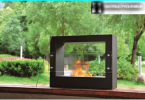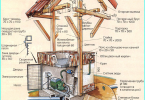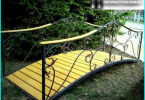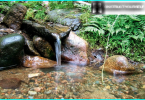
Natural stone in all times was considered to be the most popular building material. Granite, marble, Sandstone, dolomite, limestone are reliable and extraordinarily beautiful Foundation to build the foundations and houses, installation of ponds and paving, creating architectural elements and landscaping of the buildings. Not less popular in recent years, the use of artificial analogues of natural stone that have the same aesthetic look, but have higher quality characteristics. Laying decorative stone is an easy process to master which any man having the slightest idea about the finishing works.
The contents
Features «wet» and «dry» ways of stacking
Technology of laying of artificial and natural stones, having a regular geometric shape, based on the familiar principles of bricklaying. But to work with «wild» stones, known for their imperfect shape, you need more advanced knowledge and skills.
Laying stone can be made on the basis of a binder and a bonding solution, and without its use. On this basis, in construction distinguish «wet» and «dry» methods of masonry.
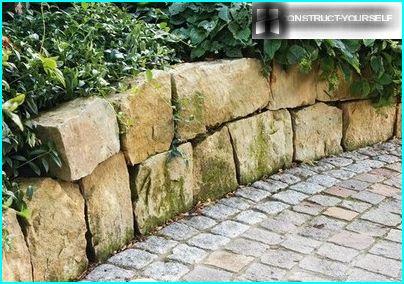
A characteristic feature of «dry» clutch is a thorough selection of the maximum matching stones and meticulously fitting them together
«Dry» technology is particularly difficult when working with natural «torn» stones, each of which has inherent thickness, height and width. To increase the durability and reliability of masonry, all the gaps between the stones are filled with earth or fastening construction mixes. This method is often used in the construction of low fences and fences, as well as laying of curbs. Here is an example «drywall»:
«Wet» the same brickwork used in the construction of high buildings, which is a one-piece monolithic construction. This method of laying is simpler because it does not provide careful adjustment of neighboring elements.
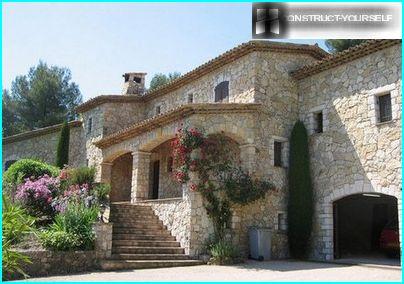
Fill cracks and voids between the stones the mortar provides the hardness and stability of any buildings
Natural stones are mostly wrong «torn» form. When selecting stones, it is important to consider the load. Stone tiles, the thickness of which does not exceed 1-2 cm, it is used for lining the vertical planes of the facades. When constructing sites with high traffic enough to use as a cover the stones with a thickness of about 2 cm And for areas which are expected to place heavy construction and equipment, need to take the stones of a thickness exceeding 4 cm.
Rubble of natural stone
Length of rubble stone varies usually in the range of 150-500 mm. Hard and durable stones are good for the arrangement of foundations, retaining walls, hydraulic structures and other buildings. Quarry stone before installation is subjected to a thorough cleaning. Large boulders split and crushed into small pieces.
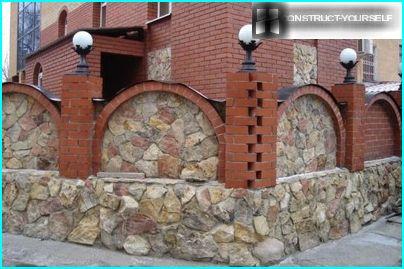
For laying of rubble stones with their hands to fit the raw large pieces of rocks: limestone, granite, dolomite, tuff, Sandstone, limestone
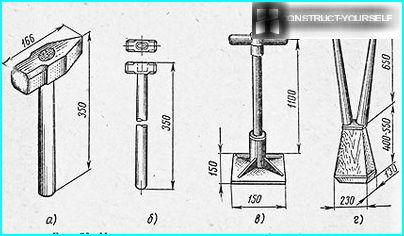
For natural stone you will need: a sledgehammer, used a small hammer to metal rammer, Mr. wood rammer
In the process plintovki is crushing boulders with application of 5 kg sledge hammers and chipping the pointed corners of small stones with a hammer weighing 2.3 kg. that’s Roughly how it’s done:
In the construction of vertical structures the largest and most stable stones set as the base, in the bottom row. They are also used when constructing corners and intersections of walls. Laying subsequent rows, you need to ensure that the seams have been shifted slightly relative to each other. This will improve the durability and reliability of constructed facilities.
The solution spread on the rocks with a small surplus. In the process of laying stones utaplivajut in cement mortar by using hammer-fist. After compaction, the excess spread in the vertical joints between the stones. The gaps between the boulders is filled with rubble and small stones. The most neat look, the seams, the width of which along its length a number of not more than 10-15 mm.
Council. If the solution got on the front of the stone, is it right to wipe with a wet cloth – this will only lead to the fact that clogged the pores of rock. It is better to leave the solution on time, so he froze, and then remove with a spatula and wipe the stone surface with a dry cloth.
Because the bandaging of seams of the booth and boulders of irregular shape to perform very problematic during laying natural stone you must place the rows of stretcher bond bonder and stones.
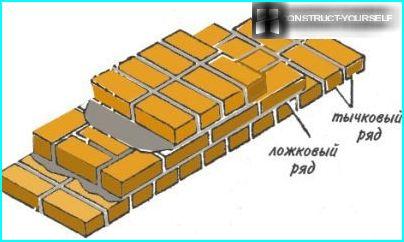
This dressing is based on the principle of chain of bandaging, which is often used in laying bricks. Thanks to this technology the design is more sturdy and durable
At the final stage you must use the spatula to perform the grouting and, if necessary, rinse the cover with running water.
As an example, this «wet» technology it is possible to show this retaining wall:
Manufacturer and regulations of installation of artificial stone
As an example, the manufacture of artificial stone with their hands, we want to offer you this instructional video of 2 parts:
Now we can talk about the rules of installation. In the process of laying artificial stone it is possible to apply the method «with jointing» or without them.
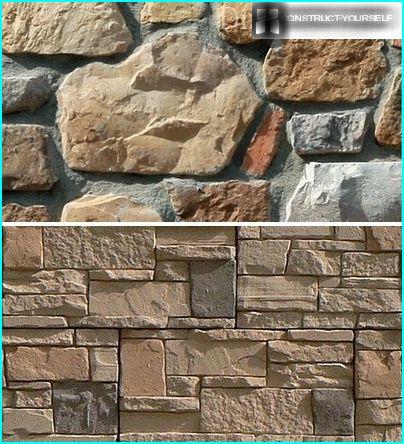
In the first embodiment, when laying the stones kept the distance between them is 1-2 cm, the second – the stones are compacted close to each other
Artificial stones mostly have a rectangular shape. Therefore, to work with them to apply the technology of laying bricks. Clutches «stretcher» — method of laying bricks in which it is placed long edge to the outer side of the structure, and masonry «poke» — when the stone is located narrow rib.
About the construction of structures made of artificial stone is most often used of classical method, in which a process «stretcher bond» laying each subsequent row is placed with some offset of the bricks relative to the previous.
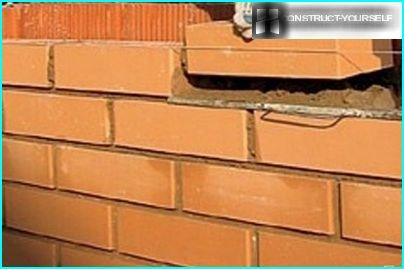
With this method of ligation of the vertical joints nearby rows do not match, thereby increasing the strength of the building
Among the most popular decorative methods of masonry can also be identified: the Flemish, the English and American.
Decorative stones are used not only for the erection of buildings and the creation of the landscape design elements, but rather for their design. The basis for their production is: granite, agglomerate or cement mortar..
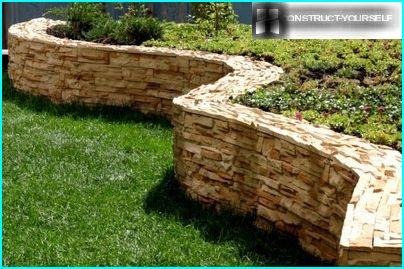
The outer surface of the cladding artificial stone can reproduce the peculiarities of any natural stone: marble, limestone, slate…
To the coated surface retains an aesthetic appearance for a long time, for laying of decorative stone, you must follow several guidelines:
- To think in advance «figure» masonry. The alternation of shapes and sizes of stones, made in light and dark shades will help to give the surface a natural and more attractive appearance.
- Comply strictly with the technology of masonry. Unlike stones used for building, decorative stones should be spread in rows, starting from the top and falling down. This will help prevent getting adhesive on the outer surface of the stone, which is difficult to clean.
- Apply the glue specified by the manufacturer of decorative stone. The adhesive mortar is applied with a spatula as the basis, and on the opposite side of the stone.
A laying carry out on the leveled, degreased surface. For better adhesion the surface should be moisten with water. The tile with the applied adhesive composition should vibrating movements tightly pressed to the surface of the base and a couple of seconds to fix. In the process of laying should avoid long vertical seams.
After installation, to decorative stone lasts as long as possible, it is desirable to cover it with a protective soil or water repellents.


